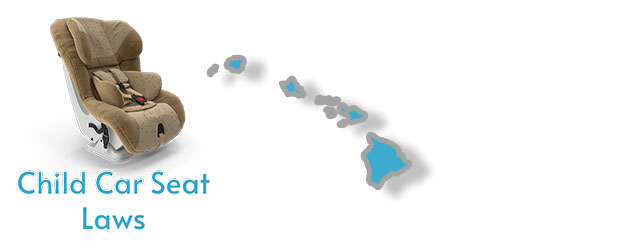A Summary of Child Car Seat Laws in Hawaii

- Rear-facing seats can be used by children until they weigh 20 pounds or more and are at least 1 year old.
- Children should exceed the rear-facing weight and height limit before transitioning to the next seat.
- The law requires children 4 years or older but younger than 8 years to ride on a booster seat.
- Children below the age of 8 are required to sit in the back seat.
Rear-facing Car Seat Laws in Hawaii
According to the state law, children should ride on rear-facing car seats until they are at least 1 year old and weigh 20 pounds or more. However, pediatrics recommend children should use a rear-facing seat until they are at least 2 years old and weigh 20 pounds or more. The goal here is for children to stay in rear-facing seats for as long as possible, and that’s why car seat manufacturers are now making convertible seats that can support infants of up to 40 pounds. When using this seat, children should be buckled up in the back seat and away from an airbag. Also, the seat used must be certified and installed in line with the accompanying manual.
Forward Facing Car Seat Laws in Hawaii
Once your toddler is at least 1 year old and weighs 20 pounds or more, the state law considers him or her to have outgrown the rear-facing seat and can now graduate to a forward-facing seat. However, it’s recommended to transition your child to this type of seat when he or she has reached the maximum weight and height limits set by the manufacturer. You must use the seat’s harness straps to secure your child to limit the forces exerted on him or her during a car crash. The seats must also be kept in the back seat of the car and be installed according to the manufacturer’s instructions. Before transitioning your child to the next seat, it is a good idea to check the car seat manual’s height and weight limits.
Booster Seat Regulations in Hawaii
Hawaii law requires children under 4 years to be restrained in a child passenger restraint device (this includes rear-facing and forward-facing seats). The law also requires children 4 years or older but younger than 8 years to ride on a booster seat. Booster seats should be used together with a lap and shoulder belt. For a safe and perfect fit, the shoulder belt should cross over the chest and the lap belt should snugly cross the hips. If your vehicle is equipped with lap belts only, the law allows you to use child safety seats that are designed to support children of up to 80 pounds. Children should remain in booster seats until they reach a height of 4’9’’, an age of 8 years, and weigh 80 pounds or more. The state recommends children should only transition to regular seat belts when they can comfortably sit with their backs against the back of the seat and knees bent at the edge of the seat without slouching.
Requirements for children to use the front seat in Hawaii
Hawaii car seat laws state children below the age of 8 should sit in the back seat. Therefore, this means your child can legally sit in the front seat as long as they are 8 years or older. But according to most manufacturers and pediatrics, it is safe for children to sit in the back seat until they are 13 years of age. It may also help to note that the recommended height for regular seat belts is 4’9’’ or more. For a seat belt to fit, the shoulder belt must lie across the chest (not the neck) and the lap belt should lie across the upper thighs (not the stomach).
Law on Leaving a child in a car in Hawaii
It is illegal to leave a child inside a car for more than 5 minutes, although we do not recommend leaving your child unattended in a vehicle for any length of time.
Car Seat Laws Exemptions in Hawaii
Emergency vehicles and taxis are exempt from complying with the Hawaii car seat laws.
More Hawaiian Laws